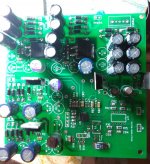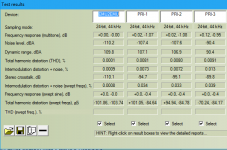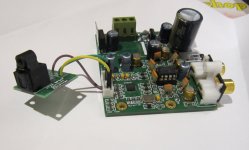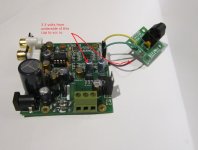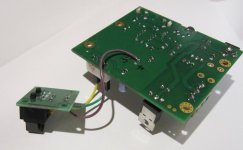I have receive the suptronics x4000k diy kit and installed last night. Please forget my poor English....
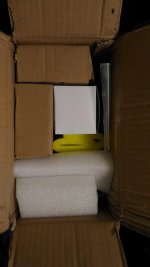
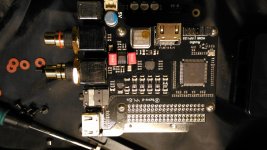
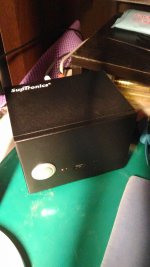
This kit include:
1) Metal Box. It is a tiny box and almost like 3 cigarette box.
2) DAC Board. Use ES9018K2M and can connect raspberry pi by I2S or HDMI I2S. I think the I2S of HDMI is much better than the ones of raspberry pi.
3) 2.5 HD Board. That board use USB port.
4) Power Supple. DC 5V 4A adapter for all kit.
5) Tools. A screwdriver & a tweezers.
That is a useful kit. I have try ES9023/PCM5102/PCM5122, and I do not like the sound. I think that is due to the quality of pi's I2S. Then I try to use to CS8421 with PCM1794 and feel better.
That kit is specially in I2S of HDMI. I am trying it....



This kit include:
1) Metal Box. It is a tiny box and almost like 3 cigarette box.
2) DAC Board. Use ES9018K2M and can connect raspberry pi by I2S or HDMI I2S. I think the I2S of HDMI is much better than the ones of raspberry pi.
3) 2.5 HD Board. That board use USB port.
4) Power Supple. DC 5V 4A adapter for all kit.
5) Tools. A screwdriver & a tweezers.
That is a useful kit. I have try ES9023/PCM5102/PCM5122, and I do not like the sound. I think that is due to the quality of pi's I2S. Then I try to use to CS8421 with PCM1794 and feel better.
That kit is specially in I2S of HDMI. I am trying it....
It does not need op for LPF?
its unfinished state.
Still need XO and LPF circuit
its unfinished state.
Still need XO and LPF circuit
You change a lot from PCB design.
Hi
I have been listening to the board for a couple of weeks now. The detail and sound stage is really great. Yes the PSU sucks, but for £10 is a lot of DAC for your money.
I have tried all then I2S drivers in moode 3.1, but one problem persists: If I change tracks while in the middle there is an audible click as the new track starts. Hence when skipping through an album can be quite irritating.
It's like the buffer for the current track is not cleared before the next track is loaded. If I find a quiet spot on the track and change from there is does not happen, suggesting it is residual data that is causing the issue.
Does anyone know how to tweak the ALSA config or have another driver that might fix this?
Sent from my iPad using Tapatalk
I have been listening to the board for a couple of weeks now. The detail and sound stage is really great. Yes the PSU sucks, but for £10 is a lot of DAC for your money.
I have tried all then I2S drivers in moode 3.1, but one problem persists: If I change tracks while in the middle there is an audible click as the new track starts. Hence when skipping through an album can be quite irritating.
It's like the buffer for the current track is not cleared before the next track is loaded. If I find a quiet spot on the track and change from there is does not happen, suggesting it is residual data that is causing the issue.
Does anyone know how to tweak the ALSA config or have another driver that might fix this?
Sent from my iPad using Tapatalk
Hi
I have been listening to the board for a couple of weeks now. The detail and sound stage is really great. Yes the PSU sucks, but for £10 is a lot of DAC for your money.
I have tried all then I2S drivers in moode 3.1, but one problem persists: If I change tracks while in the middle there is an audible click as the new track starts. Hence when skipping through an album can be quite irritating.
It's like the buffer for the current track is not cleared before the next track is loaded. If I find a quiet spot on the track and change from there is does not happen, suggesting it is residual data that is causing the issue.
Does anyone know how to tweak the ALSA config or have another driver that might fix this?
Sent from my iPad using Tapatalk
People say: try to increase Audio Buffer Size & Buffer Before Play.
In my case: one track to another is fine, but one type file to another type file not. Example, from flac to flac file is ok, but from mp3 to flac does not.
I set my I2S audio device as PRI-DAC and volume control as disable.
Thought this may be of interest...I bought 2 of these https://www.aliexpress.com/item/201...32727675710.html?spm=2114.13010608.0.0.wBuiAb
as a stop-gap measure while I built the diyinhk version..
ES9018K2M XMOS DSD DXD 384kHz USB DAC with Bit-perfect volume control and SPDIF input - DIYINHK.
Having finished the build I now have the diyinhk unit connected to the xmos previously on the Chinese board.
I didn't want to shell out for another xmos so wondered if the DIYINHK toslink adapter could be added so I could use the original cheapo chinese board as an external card for a laptop or upgrade for a cd transport... and it can
I followed the advice on the diyinhk page...
and used their adapter...192K Optical SPDIF receiver - DIYINHK
Connected output to pin 2 and ground to pin 5 of the i2s input and ran a wire from under the board from the +ve of the 22uF cap (label on board says 100uF) directly above the TLJ1117-3 3.3v regulator to vcc in of the receiver.
Powers up and works fine running from the optical out of a cd player.
Will test tomorrow with a laptop and see how high a sample rate it supports. Diyinhk claim 192/24.
as a stop-gap measure while I built the diyinhk version..
ES9018K2M XMOS DSD DXD 384kHz USB DAC with Bit-perfect volume control and SPDIF input - DIYINHK.
Having finished the build I now have the diyinhk unit connected to the xmos previously on the Chinese board.
I didn't want to shell out for another xmos so wondered if the DIYINHK toslink adapter could be added so I could use the original cheapo chinese board as an external card for a laptop or upgrade for a cd transport... and it can
I followed the advice on the diyinhk page...
This ES9018K2M DAC can also be used standalone to receive SPDIF directly, the 3.3v SPDIF should be connect to the 20pin header labelled BCK and GND)
and used their adapter...192K Optical SPDIF receiver - DIYINHK
Connected output to pin 2 and ground to pin 5 of the i2s input and ran a wire from under the board from the +ve of the 22uF cap (label on board says 100uF) directly above the TLJ1117-3 3.3v regulator to vcc in of the receiver.
Powers up and works fine running from the optical out of a cd player.
Will test tomorrow with a laptop and see how high a sample rate it supports. Diyinhk claim 192/24.
Attachments
Last edited:
Hi Drone7 - my chinese board also has the LM7805 ready populated. I was thinking about using this 5 volt output to power a Pi 0 running Moode 3.5 (when released). Do you know what current is supplied from that output, or what current the Xmos usb device draws? The advantage would be only one reasonably high quality power supply will be needed. I generally build linear power supplies for the Pi/Dac combos I use - with mains power filters before shielded toroid or Rcore transformers, and then LDO regulators in a low ripple circuit.On the original board (first one pictured in this link...http://www.diyaudio.com/forums/digi...-chinese-es9018k2m-i2s-dac-2.html#post5028095)
The two hole land is an output to power the matching xmos usb device and the three hole land is populated by an LM7805 regulator for this purpose. Looks like this was omitted on your board.
NEWEST XMOS U8 USB 384K 32B I2S SPDIF output,support DSD for es9018 DAC | eBay
LM7805 is a bit long in the tooth for this.Hi Drone7 - my chinese board also has the LM7805 ready populated. I was thinking about using this 5 volt output to power a Pi 0 running Moode 3.5 (when released). Do you know what current is supplied from that output, or what current the Xmos usb device draws? The advantage would be only one reasonably high quality power supply will be needed. I generally build linear power supplies for the Pi/Dac combos I use - with mains power filters before shielded toroid or Rcore transformers, and then LDO regulators in a low ripple circuit.
This supply using the Lt3080 is a good compromise between performance and cost....
https://jarretdyrbye.wordpress.com/...y-for-hi-fi-usb-audio-with-your-raspberry-pi/
But the diyinhk supply at the end of this post is much preferred and it will power a number of devices...dacs, pis,..etc
The best Raspberry Pi power supply - RaspyFi
I don't know the current draw of the xmos but this may help...
https://www.xmos.com/support/appnotes/AN01005
https://www.jeffgeerling.com/blogs/jeff-geerling/raspberry-pi-zero-power
Raspberry Pi – power supply noise on the 5V rails | Crazy Audio
7805 is not enough for a Rpi. You should not be drawing more than 100mA for the one on the board, specially if you have a 12V input or so for decent performance of the opamp. Even then, the regulator will run hot.
I got a couple of units last night to shake down and see what they can do. The V-I converter uses unusually large resistor values, pointing to a DAC starved of current , as expected for a mobile part. There is quite a bit of variation between the two units in terms of subjective performance, though I might measure them at some point.
The sound is above average for a unit of this price range. I have it running off a Pi in a $11 case, and two separate wall warts for the DAC and Pi. No idle noise and no other overall issues, though as expected it performs better at the top of its range, the soundstage and timbre collapse at the usual -20 to -15dB level. When in a properly gain-staged system, I guess it can easily satisfy any casual user. I did noitce large transients when switching tracks if resampling was enabled in Moode. I assume the buffer size needs to go up a few notches, though there will be a resultant delay in playback. I may yet experiment with that later.
I got a couple of units last night to shake down and see what they can do. The V-I converter uses unusually large resistor values, pointing to a DAC starved of current , as expected for a mobile part. There is quite a bit of variation between the two units in terms of subjective performance, though I might measure them at some point.
The sound is above average for a unit of this price range. I have it running off a Pi in a $11 case, and two separate wall warts for the DAC and Pi. No idle noise and no other overall issues, though as expected it performs better at the top of its range, the soundstage and timbre collapse at the usual -20 to -15dB level. When in a properly gain-staged system, I guess it can easily satisfy any casual user. I did noitce large transients when switching tracks if resampling was enabled in Moode. I assume the buffer size needs to go up a few notches, though there will be a resultant delay in playback. I may yet experiment with that later.
7805 is not enough for a Rpi.
May be enough for a Pi Zero?
Maybe not. The Pi 0 may ask for up to 150mA @full load, and that is without a single connected USB device.
At 7V drop and this 140mA, the regulator will dissipate about a watt, enough for it to run very, very hot - you could burn your finger on it. A small sink will be needed, along with a bit of ventilation. And even so, you can connect nothing except a powered USB hub for anything else.
It might just be better to get something that is actually properly prepared for this task. I shall be using the 7805 to power a little Bluetooth-I2S board (using a few diodes to drop the voltage down to ~3.7V), which is under 30mA, and quite possible for the regulator on the second unit.
At 7V drop and this 140mA, the regulator will dissipate about a watt, enough for it to run very, very hot - you could burn your finger on it. A small sink will be needed, along with a bit of ventilation. And even so, you can connect nothing except a powered USB hub for anything else.
It might just be better to get something that is actually properly prepared for this task. I shall be using the 7805 to power a little Bluetooth-I2S board (using a few diodes to drop the voltage down to ~3.7V), which is under 30mA, and quite possible for the regulator on the second unit.
I guess I'll stick with separate discrete linear power supplies for the dac and the Pi - too marginal with the onboard dac 5v feed. Thanks for the comments. On a separate note, I've just received one of the chinese ess9028Q boards (not tried it yet). It has the space for the 7805 etc, but is not populated. There are also additional spaces for components and connectors on the board - some of them look to be for indicator leds - labelled OTP, USB, COX, AUX, PCM, DSD. Anyone have any idea what they are for? Of course, the board comes with no documentation or instructions.....
If you could post some high resolution close-ups, it might help us figure it out. The ones on eBay are too small for any meaningful conclusion, which is probably deliberate.
To help you work out the power issues, what I will be doing is using an Apple 12W charger to power everything, along with LC filtering at the input and a 5V-12V 3W switcher for the DAC. The switcher will also power an onboard buffer (think standard EF buffer, but with a JFET). Volume control will be provided by a stepped attenuator.
Each section will have heavy LC filtering, and the 12V converter is a fully isolated unit so ground loops are not an issue. The buffer will have dedicated capacitance multiplier. All of this so I can turn on one switch and have a nice source/preamp to test amplifier builds. Right now it's either dragging everything into my main setup, or using the 3.5mm jack of a mobile phone. One's too clunky, the other's not good enough.
To help you work out the power issues, what I will be doing is using an Apple 12W charger to power everything, along with LC filtering at the input and a 5V-12V 3W switcher for the DAC. The switcher will also power an onboard buffer (think standard EF buffer, but with a JFET). Volume control will be provided by a stepped attenuator.
Each section will have heavy LC filtering, and the 12V converter is a fully isolated unit so ground loops are not an issue. The buffer will have dedicated capacitance multiplier. All of this so I can turn on one switch and have a nice source/preamp to test amplifier builds. Right now it's either dragging everything into my main setup, or using the 3.5mm jack of a mobile phone. One's too clunky, the other's not good enough.
I guess I'll stick with separate discrete linear power supplies for the dac and the Pi - too marginal with the onboard dac 5v feed. Thanks for the comments. On a separate note, I've just received one of the chinese ess9028Q boards (not tried it yet). It has the space for the 7805 etc, but is not populated. There are also additional spaces for components and connectors on the board - some of them look to be for indicator leds - labelled OTP, USB, COX, AUX, PCM, DSD. Anyone have any idea what they are for? Of course, the board comes with no documentation or instructions.....
I have this board linked up with a Pi Zero, running Picoreplayer. Either feeding a TPA3116 or headphones, I'm impressed so far. I'm also intrigued by the additional LED positions, the extra pins and what look like switch pads (DEL, VOL_, VOL- from memory)
I guess I'll stick with separate discrete linear power supplies for the dac and the Pi - too marginal with the onboard dac 5v feed. Thanks for the comments. On a separate note, I've just received one of the chinese ess9028Q boards (not tried it yet). It has the space for the 7805 etc, but is not populated. There are also additional spaces for components and connectors on the board - some of them look to be for indicator leds - labelled OTP, USB, COX, AUX, PCM, DSD. Anyone have any idea what they are for? Of course, the board comes with no documentation or instructions.....

That one?
Yes - that one. The extra component spaces are down at the bottom right of the picture - leds, resistors, and also some switch pads and connector pins.
Forget it.
I have ask the seller and they say these design is for other project, need firmware to enable these function. They do NOT promise these function.
Last edited:
- Home
- Source & Line
- Digital Line Level
- Chinese ES9018K2M I2S DAC
